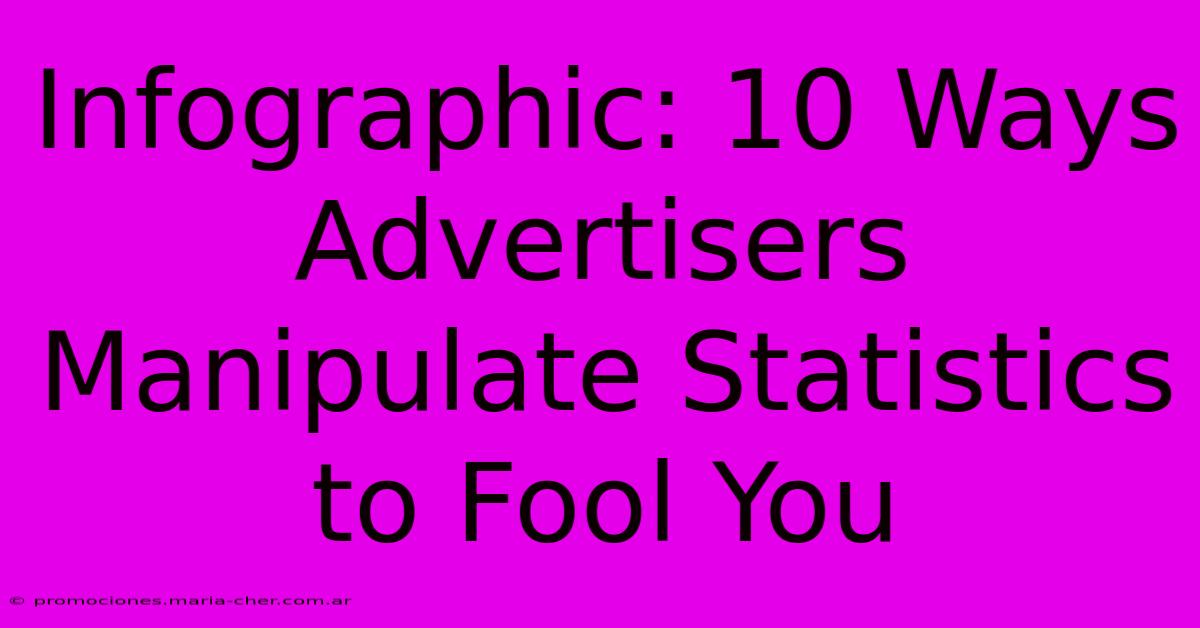Infographic: 10 Ways Advertisers Manipulate Statistics To Fool You

Table of Contents
Infographic: 10 Ways Advertisers Manipulate Statistics to Fool You
We're constantly bombarded with advertising. Clever slogans, eye-catching visuals, and persuasive narratives all vie for our attention. But lurking beneath the surface of many advertisements are subtly manipulated statistics, designed to mislead and influence our purchasing decisions. This infographic reveals ten common tactics advertisers employ to distort data and manipulate your perception. Understanding these techniques will empower you to become a more discerning consumer and avoid falling prey to misleading marketing claims.
Deceptive Advertising Statistics: A Consumer's Guide
Statistics can be powerful tools, capable of lending credibility and weight to even the most dubious claims. However, advertisers often exploit the average consumer's limited statistical literacy to create a false sense of authority and desirability for their products or services. Let's explore some of the most prevalent deceptive techniques:
1. Cherry-Picking Data: Showing Only What Supports the Claim
This is a classic deceptive tactic. Advertisers selectively choose data points that support their claim while ignoring contradicting evidence. For example, highlighting a small increase in sales while ignoring a larger overall decline. Always look for the complete picture, not just the carefully selected snippets.
2. Misleading Graphs and Charts: Distorting Visual Representations
Visually appealing charts and graphs can be easily manipulated to exaggerate or downplay results. Watch out for misleading scales, truncated axes, or confusing 3D effects. These techniques distort the actual relationships between data points, making a small difference appear significant.
3. Unrepresentative Samples: Drawing Conclusions from Biased Data
A sample should accurately reflect the target population. However, advertisers often use small, biased, or non-random samples to support their claims. For instance, a survey conducted only among existing customers is unlikely to provide an objective perspective.
4. Confusing Correlation with Causation: Linking Unrelated Events
Just because two things happen together doesn't mean one caused the other. Advertisers frequently exploit this fallacy, linking their product to a desirable outcome without establishing a genuine causal relationship. For example, claiming that using a certain product will lead to improved health without providing supporting scientific evidence.
5. Vague and Unquantifiable Claims: Avoiding Specific Numbers
Beware of ambiguous phrases like "significantly better" or "up to 50% improvement." These lack specific numerical data and make it impossible to verify the claim's validity. Demand precise figures and detailed explanations.
6. Omitting Crucial Information: Hiding Important Details
Advertisers might present only part of the story, leaving out details that contradict their claims. Always look for fine print or disclaimers that may reveal hidden costs, limitations, or unfavorable side effects.
7. Using "Average" Without Specifying the Type: Misleading Averages
There are different types of averages (mean, median, mode). Advertisers might use the type that best suits their purpose, even if it's not the most representative. Always clarify which type of average is used.
8. Misrepresenting Percentages: Inflating the Importance of Small Changes
A seemingly small percentage increase can be magnified to appear significant. Consider the context and the base number. A 10% increase on a small initial value is far less impactful than a 10% increase on a large one.
9. False Precision: Implying Greater Accuracy Than Exists
Advertisers might use numerous decimal places to give a false impression of accuracy. Remember that precision doesn't necessarily equal accuracy. Be skeptical of claims with excessive detail that lacks supporting evidence.
10. Playing on Emotions: Appealing to Fear, Hope, or Desire
Instead of relying on logic and data, many advertisements tap into emotions. This emotional appeal can override critical thinking, making you more susceptible to misleading statistics. Learn to identify and counteract emotional manipulation in advertising.
Become a Savvy Consumer: Spotting Statistical Deception
By understanding these common tactics, you can become a more informed and critical consumer. Always question the source of information, look for supporting evidence, and be wary of overly simplistic or emotionally charged claims. Don't let advertisers manipulate you with deceptive statistics! Your purchasing power is your voice; use it wisely.
Keywords: deceptive advertising, misleading statistics, advertising manipulation, data manipulation, statistical literacy, consumer awareness, critical thinking, marketing tactics, infographic, false advertising, statistical deception, data distortion, consumer protection.

Thank you for visiting our website wich cover about Infographic: 10 Ways Advertisers Manipulate Statistics To Fool You. We hope the information provided has been useful to you. Feel free to contact us if you have any questions or need further assistance. See you next time and dont miss to bookmark.
Featured Posts
-
Transform Your Social Media Presence Elevate Your Self Portraits With Pro Level Editing Tricks
Feb 08, 2025
-
The Candy Coated Key To Unlocking Googles Top Spot M And Ms Font Seo Success
Feb 08, 2025
-
The Pink Quartz Birthstone A Rose Tinted Journey To Emotional Fulfillment
Feb 08, 2025
-
Connect With Your Inner Goddess Through The Pink Quartz Birthstone Love Harmony And Self Esteem
Feb 08, 2025
-
The Masters Of Monochrome A Comprehensive Guide To The Pioneers Of Black And White Photography
Feb 08, 2025
